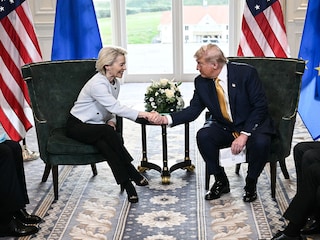From Brussels to Manila, US strikes first wave of trade deals under Trump
From the EU to Indonesia, nations begin closing trade deals with the US


The European Union became on Sunday the latest exporter to conclude a trade deal with the United States in a bid to limit damage from US tariffs taking effect on August 1.
The levies—agreed by Britain, the EU, Indonesia, Japan, the Philippine and Vietnam—are generally higher than the new base rate of 10 percent that the United States has applied to most countries since April.
But they are lower than the levels of customs duty the administration of President Donald Trump threatened to impose on August 1 if no deal were reached.
While many details remain to be negotiated under the deals, the countries concerned made considerable concessions to reach an agreement with the United States.
Trump said a baseline tariff of 15 percent would apply across the board, including to Europe"s crucial automobile sector, pharmaceuticals and semiconductors.
That is lower than the blanket 30-percent tariffs Trump had threatened to impose next week but significantly higher than the duties in place to date.
As part of the deal, the 27-nation EU has agreed to purchase energy worth $750 billion from the United States and make $600 billion in additional investments, according to Trump.
He said EU countries—which recently pledged to ramp up their defence spending within NATO—would be purchasing "hundreds of billions of dollars" worth of military equipment".
The two sides have agreed bilateral tariff exemptions on a number of "strategic products", notably aircraft, certain chemicals, some agricultural products and critical raw materials.
Von der Leyen said the EU still hoped to secure further "zero-for-zero" agreements, notably for alcohol, which she hoped to be "sorted out" in the coming days.
Trump indicated the European pharmaceutical sector, for which the US is a key market, would not receive special treatment.
France"s minister for Europe, Benjamin Haddad, said on Monday the agreement was "unbalanced" and Germany"s BDI business federation said the accord would have "considerable negative repercussions".
Crucially, Tokyo managed to cut to 15 percent an existing, painful 25-percent tariff on its automobiles, an industry accounting for 30 percent of Japanese exports to the US in 2024.
Moody"s Analytics analyst Stefan Angrick said 15 percent was still much higher than the low single-digit rates in effect before Trump returned to the White House.
"It"s not exactly good news," he noted.
Fifty-percent tariffs on Japanese steel and aluminium will continue to apply.
The White House said that under the deal, Japan would make $550 billion in investments in the United States.
These would be in areas including energy infrastructure, semiconductor and drug manufacturing, the mining and production of critical minerals, as well as commercial and military shipbuilding.
Washington said the United States would retain 90 percent of the profits from these investments and Japan would buy $8.0 billion worth of US goods, including agricultural produce, aviation fuel and 100 Boeing planes.
The White House also said Japan would lift "longstanding restrictions" on US cars and lorries—which sell poorly in Japan—and increase its imports of US rice imports 75 percent.
"The magnitude of the concessions made by the Japanese government could make one fear very complicated negotiations with others like the European Union," analyst Bastien Drut at CPR Asset Management in Paris forecast at the time of the deal.
Products from the Southeast Asian country, a major exporter of high-tech items and apparel, will face a 19-percent levy.
The deal also benefits the British aerospace sector, in particular jet engine manufacturer Rolls Royce, which won a tariff exemption.
London is still negotiating exemptions for its steel and aluminium products from the 25-percent rate in force.
In return, the UK had to open its market further to US ethanol and beef, which has caused concern domestically.
The rest of Britain"s products are subject to the 10-percent base rate.
That will see its shipments subject to a 20-percent tariff, instead of the threatened 46-percent rate.
But a 40-percent tariff will be imposed on goods manufactured in third countries that transit Vietnam to circumvent steeper trade barriers.
US goods will not face any tariffs to enter Vietnam.
Certain Indonesian goods not available in the United States could face even lower rates.
According to Washington, nearly all US goods will be able to enter Indonesia tariff free.
Moreover, it said Jakarta had agreed to recognise US standards for car and pharmaceutical imports.
It also agreed to drop a plan to tax data flows and to ease export restrictions on critical minerals.
Indonesia had already made other concessions earlier in July, pledging to buy more US oil and agro-industrial goods.
First Published: Jul 29, 2025, 12:36
Subscribe Now